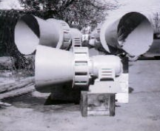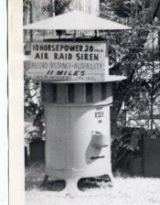Hedberg Super Sirens
Hedberg Super Sirens, also Hedberg Siren Company and Hedberg Manufacturing Company[1], was a manufacturer of vehicular and outdoor warning sirens, based in San Jose, CA, started by James Napoleon Hedberg in 1920. Hedberg's "long-rolling" vehicular sirens are widely renowned as having the longest coasting wind-downs of any vehicular siren ever made thanks to the use of a brush lifting mechanism.
History
The Hedberg Manufacturing Company was formed in 1920 by James N. Hedberg. After failing to hear a motorcycle officer's siren and getting a speeding ticket, Hedberg decided to build a better performing siren for the police department, creating so much demand that he was able to make a living from producing sirens for the next 35 years. Hedberg created both electric and friction sirens for vehicular use, and later would also produce large outdoor warning sirens for Civil Defense use. Hedberg was well-known for being an eccentric man, and there are many stories involving him. Lacking access to high-speed DC electric motors, Hedberg was known for scouring local scrapyards to take the Wagner Electric starter motors from derelict Studebaker automobiles to use in his sirens after rewinding them.[2]
Hedberg was known for producing its own fire apparatus between 1938 and 1954, based on Mack and GMC chassis. These were used by the San Jose Fire Department as late as 1970 before being retired. Hedberg also was the head of his own personal fire department in the 1930s and 1940s, with his own employees making up most of the firefighters. These "Hedberg Volunteers" fought fires outside of the San Jose city limits, who would be out of range of the San Jose Fire Department and would not otherwise have any firefighting capability.
In 1955, James Hedberg sadly passed at age 73. For the last three years of his life, ownership of the company was handed over to his wife, Selma Hedberg, as James was in semi-retirement. After Hedberg's death, the company was sold to Charles Leland Aplin, who continued to produce the same sirens with very few staff under the new name, "Hedberg Manufacturing Company." Presumably by lack of success, the company was sold to John C. Davis and Richard D. Betzler of El Monte, CA on Halloween of 1960. Siren production ceased, and the company was turned into the Hedberg Manufacturing & Chemical Company, which made fuel detergents and extenders for cars. The last mention of this company was in the 1980s.
The Hedberg company's headquarters were abandoned upon the company's demise, and would be unfortunately demolished along with the rest of the area to make room for the Interstate 280-Gaudalupe Expressway interchange leaving no trace. Today, little to no Hedberg sirens are left in regular use, but many remain on display and parade fire engines, and in the private collections of many fire apparatus and siren enthusiasts. Only one Hedberg outdoor warning siren is known to still be in use, a vertical model in Comptche, CA.
Outdoor warning sirens
Belt/chain driven sirens
Hedberg's earliest venture in the outdoor warning siren market was a series of indirect-drive sirens of various sizes, which were available in the 1920s and 1930s. These sirens are all 6-port, but run at approximately 7,000 RPM by use of a 2:1 pulley or sprocket reduction, with a belt or chain respectively, driven by a 3,500 RPM motor. This series seemed relatively unsuccessful, as very few examples have been documented over the years, and no large models are currently known to exist. This is presumably due to the stress such a large rotor would have to endure at such a high speed, and it is very likely that rotors or other drive system components failed frequently, especially when considering that these sirens are very under-engineered.
Chain driven (small)
WIP
Belt driven (large)
WIP
10 hp Horizontal

Hedberg's 10 horsepower horizontal siren was one of the company's best-selling outdoor sirens, having the most documented installations. The siren is 12-port, with a single large 20 inch diameter rotor that has curved vanes, similar to a B&M siren. It has a large intake horn on the front, and stood on a tapered motor stand. Some came with motor hoods, while others had exposed weatherproof motors. The siren saw somewhat widespread use in California, with installations of multiple units known in San Jose, Palo Alto, and potentially Oakland. It was in production as early as 1942, and presumably lasted until 1960 when the company sold for the final time.

10 hp Vertical
The 10 horsepower vertical Hedberg, despite not having as many documented installations, still seemed to sell fairly well. Like the horizontal siren, it has a single 12-port, 20 inch diameter rotor with curved vanes. It has a large cylindrical intake with a cone cover on top, a flat cowl above the stator, and sits on a 4-legged motor stand. The siren was advertised to be audible at 11 miles away. One example of the 10hp vertical siren is known to exist in Comptche, CA as an active community warning siren. No other locations are known. It was produced until around 1960 when the company sold.
Vehicular sirens
WIP
